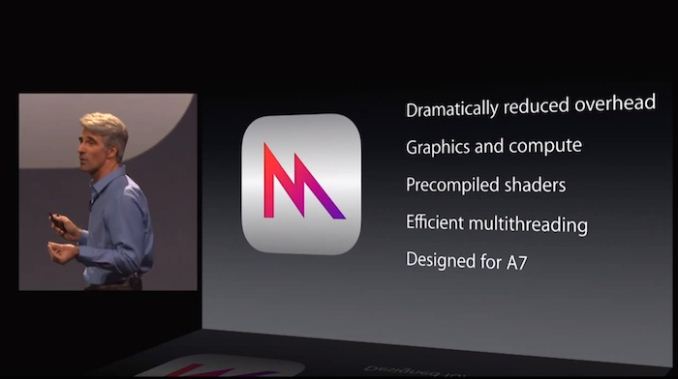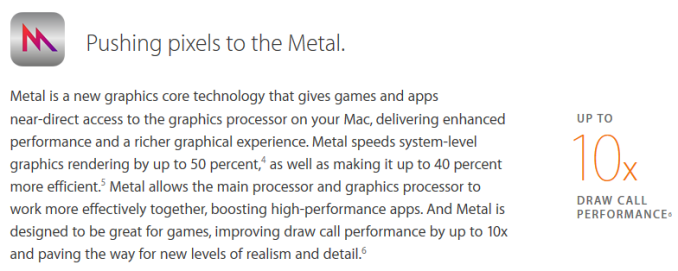Apple’s Metal API Comes to OS X Desktops
by Ryan Smith on June 10, 2015 10:00 AM EST
At last year’s WWDC, Apple introduced their Metal API for iOS 8. A low-level graphics API, Metal was originally designed to bring the benefits of low-level graphics programming to Apple’s mobile operating system. And while we typically don’t think of mobile devices as being GPU-bound, in reality Apple has been packing some relatively powerful GPUs like GXA6850 with what are relatively speaking still fairly weak CPUs, which means Apple has ended up in a situation where they can be CPU-bottlenecked on draw calls.
Metal, despite being the 3rd such low-level API to be introduced, was the first to reach production status. Microsoft’s DirectX 12 is arguably not there yet (Windows 10 is still in testing), and Khronos’s Vulkan was still in its primordial Mantle form at this point in 2014. What this means is that out of all of the vendors, it’s arguably Apple who has the lead time advantage in low-level API development. Which is why for the last year we have been wondering if Metal would stay on iOS, or make the jump to OS X.
Yesterday we got our answer, with the announcement from Apple that Metal would be coming to OS X “10.11” El Capitan, and that it would be part of a larger investment into Metal for the company. Along with bringing Metal to OS X, Apple is going to be releasing new API kits that interface with Metal to simplify development, and internally Apple is now using Metal (when available) for parts of the desktop composition rendering chain. At this point it’s fair to say that Apple has gone all-in on Metal.
Consequently the fact that Metal is now over on OS X is not unexpected, but whether it has been planned for or not, it means that we now have 3 low-level APIs on the desktop as well as mobile. OS X’s Metal will be going head-to-head with Microsoft’s DirectX 12 and Khronos’s Vulkan, and this is the first time in a very long that we have seen a viable and competitive 3rd graphics API on the desktop, as DirectX and OpenGL have been the reigning APIs since the turn of the millennium.

Metal's Introduction At WWDC 2014 (Image Courtesy Apple Insider)
As for what this means for Mac users, in the short run it’s a good thing. With Vulkan still in development, had Apple not implemented Metal on OS X, OS X would have needed to stick with classic OpenGL for another year until OS X 10.12. Going with their own API, as was the case with mobile, gets a low-level API on OS X sooner. Furthermore because it’s been on iOS for the last year, Apple gets to leverage all of the developer experience and code already written for Metal, and bring that over to OS X. Which is why developers like Epic are able to show off engines using Metal on OS X so early.
In the long run however there are some big unknowns left to answer, which could have a big impact on how things play out. Apple has not yet released the complete documentation for the newest version of Metal – specifically, we don’t have feature lists – so how the Mac and iOS versions compare feature-wise remains to be seen. My biggest concern here is that Apple will put OS X and iOS at parity, essentially limiting the features available to the lowest common denominator of iOS, leading to Macs in general being behind the curve in graphics features. The other big question is whether Apple will support Vulkan next year once it’s done, or whether they will stick with Metal, essentially turning OS X’s graphics stack proprietary. Which for users could lead to a reduction in game ports to the Mac if developers have to go write against a Mac-specific graphics API.
One thing that is a pretty sure bet at this point is the GPUs that will support Metal. In short, don’t expect to see anything that can’t support Vulkan support Metal due to a lack of necessary features. So I’m expecting Metal compatibility to start with Intel’s Haswell (Gen 7.5) iGPUs, AMD’s GCN dGPUs, and NVIDIA’s Fermi/Kepler dGPUs. El Capitan works on a much wider range of machines of course, so this means only a fraction of those machines get to experience Metal. Though this was the same situation on mobile as well.
As for developers, things will be interesting. As I mentioned before Apple seems to be going all-in on Metal, starting with the fact that they will have Metal back-ends for their Core Graphics and Core Animation frameworks. And actually I’m a bit surprised by this, as basic compositing is not something that is draw call limited. Apple is claiming upwards of 50% performance increases here, so I’m curious just how this works out, but I suspect these are based on low-level benchmarks. Draw call performance is not the only benefit of Metal, but it is the most immediate, so Apple may be leveraging the harder to get GPU benefits here, or just wringing every last Joule of power out by getting to an API that isn't doing high-level state checking.

OS X Metal Performance Improvements: From Apple's Promotional Materials
In any case, by building Core frameworks off of Metal, Apple is in a position where they have to ensure Metal drivers are working well, which is to the benefit of developers. Meanwhile Apple is going one step past Metal on iOS 8 with the release of MetalKit, which is a set of utility functions for Metal to help speed Metal development. As we’ve mentioned before one of the few real pitfalls of low-level APIs is that to best utilize them you need guru-level programmers – after all, the API doesn’t have high-level safety nets to keep developers out of trouble – and with MetalKit Apple is at least partially resolving this issue by providing some base functionality for programmers.
Wrapping things up, though not an unexpected move from Apple, it will none the less be interesting to see how their efforts with Metal go. As a tightly integrated vendor they have the advantage of being able to move quickly when they choose to, which is why we’re seeing Metal come to OS X so soon and to get used by Core OS components so soon. Metal is just a graphics API, but due to Apple’s timing OS X will be the real test for low-level APIs on the desktop, and not just for gaming. Apple is in an interesting position to take advantage of these new APIs like no one else can, so in several ways they are going to be the pathfinder on just what can be done with these APIs.












63 Comments
View All Comments
WorldWithoutMadness - Wednesday, June 10, 2015 - link
I think this is also one of the reason why they went with AMD GPU.So they have a working model of low level API. I think they might still use AMD for next several generation until they completely mastered Metal before going to another GPU maker.
ltcommanderdata - Wednesday, June 10, 2015 - link
I wonder who will be developing the drivers for Metal on OS X? Is Apple going to do the drivers themselves or did they manage to convince the GPU vendors to do it?And will Ivy Bridge be supported since Apple is still selling MacBook Pros with them? I don't believe Ivy Bridge supports DX12 or Vulkan, but that might be more because Intel only releases bugfix drivers for Ivy Bridge on Windows now that Haswell and Broadwell are out rather than the hardware not actually being compatible.
taigebu - Wednesday, June 10, 2015 - link
Apple is developing all of the drivers themselves. They already do with the OpenGL drivers and they will likely do that for the Metal drivers.ltcommanderdata - Wednesday, June 10, 2015 - link
http://www.insidemacgames.com/features/view.php?ID...Apple does not currently write all the OpenGL drivers themselves. It's a plugin architecture system where Apple writes the top level that accepts the OpenGL code and produces an intermediate representation and GPU vendors write the low level code that takes that intermediate representation and runs it on each specific GPU.
tuxRoller - Saturday, June 13, 2015 - link
If that's the case then they could support vulkan as the ir has been finalized.hulu - Wednesday, June 10, 2015 - link
Multiple graphics APIs on various platforms will just mean that middleware (game engines etc.) will be even more important. They will allow developers to develop once (for the engine), then have the engine produce code for each individual platform with any compatible API. Some tweaking will be required, but nowhere near as much if you developed for each platform individually.GruenSein - Wednesday, June 10, 2015 - link
I think, there are two points to consider when discussing the issue of extra development effort and fragmentation of developer resources when trying to place metal in the general 3D/GPU-API landscape.For one, many major engines and middleware are targeting mobile devices these days. Since iOS makes up a huge chunk of the (especially money spending) user base, most of them will at least consider Metal. As mentioned above, the Unreal Engine already provides Metal support. It makes sense for mobile software and the desktop benefits presumably come with no or hardly any additional effort.
Also, since all low level GPU APIs claim to be very close to actual hardware functionality and that is the same no matter what OS you choose to run on it, I am wondering if those APIs are fairly similar at least when it comes to programming concepts. This is not true for DX (pre 12) and OpenGL and still lots of engines have supported both over the years. Syntax is another issue, of course. It might not be too much effort to add functionality of one a second/third low level API once the first one has been implemented...
stingerman - Friday, June 12, 2015 - link
Metal for iOS and OS X is virtually identical. All the development resources going into iOS game development engines, benefit OS X. Every Mac since 2012 is compatible with Metal. Besides games, Metal will underly may of the UI and vector math libraries. Metal also replaces OpenCL, so it's great for Apple's professional and scientific markets, which they are also popular in.Metal, additionally manages OS X memory transfers between a GPU's private memory and shared RAM thus reducing overhead. Of course, Macs with shared memory between the CPU and GPU will see no overhead at all. It's a very nice upgrade for OS X system wide, in addition to gaming.
loguerto - Thursday, June 11, 2015 - link
Thank you apple but we really don't need a new low level api. There is vulkan that will be efficient and multiplatform and that's all developers want, a new standard to focus on. Do your stuff but don't force us to use it.techconc - Thursday, June 11, 2015 - link
I don't really get the negative responses to Metal. Vulkan isn't here yet. Metal is. It makes sense for Apple to invest in Metal and control it's own destiny. Just because Apple's internal graphics are based on Metal doesn't mean it won't also support Vulkan when the time comes. Apple still supports OpenGL, right? This was a good move for Apple that allows them to be competitive with Microsoft, etc.